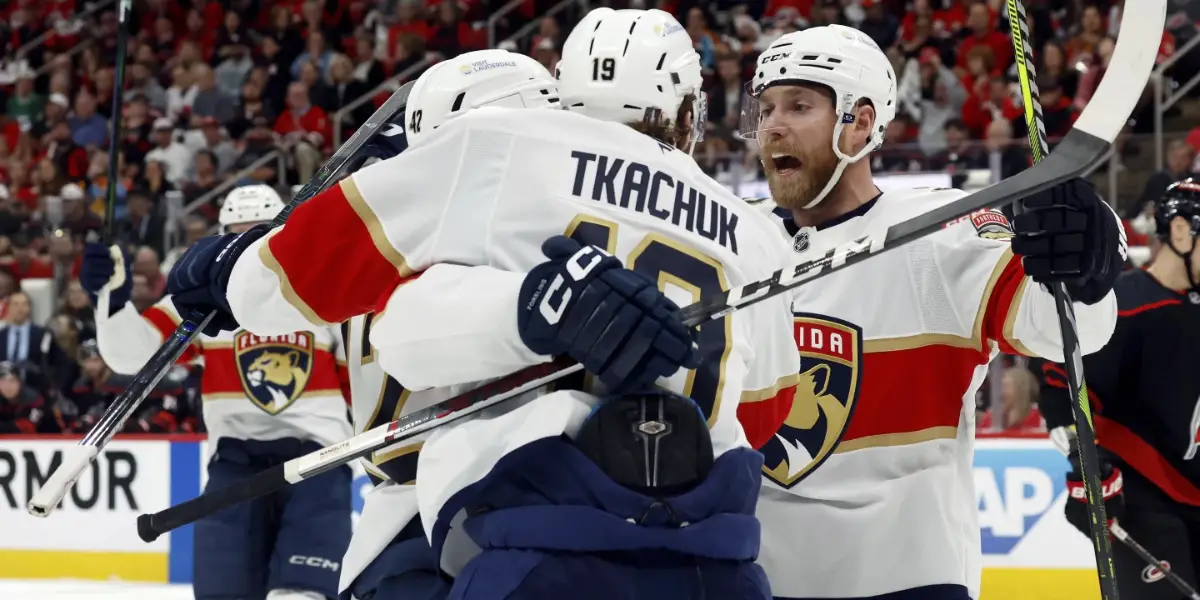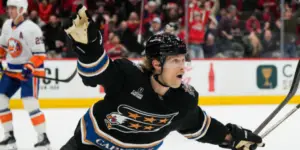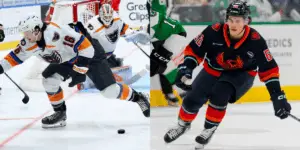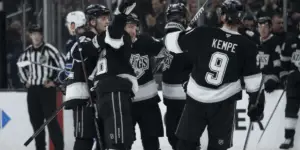
The Panthers sport a formidable second line filled primarily with players who are able to get under the skin of their opponents. However, the line looked a little different in the playoffs compared to the regular season, with Rodrigues/Verhaeghe primarily filling the LW spot, whereas rookie Mackie Samoskevich filled it for the majority of the regular season. If there’s a fight, there’s a high likelihood that this line of forwards is on the ice and probably started it in some fashion or other. They’re skilled, they’re mean, they’ve probably pissed off the opposing fanbase. Florida’s second line is built for playoff hockey.
Sam Bennett:
It was a contract year for Sam Bennett, but what a year he had. Bennett posted a career high 51 points (25G, 26A) in the regular season and a career high 22 pts (15G, 7A) in the playoffs. A postseason performance that led the NHL in goal scoring and earned him the Conn Smythe Trophy. He played 76 games during the regular season, which is the most he’s had with the Panthers; the last two years, he’s only played 63 & 69, respectively. Sam had a rotating cast of wingers during the year, with the usual Rodrigues/Verhaeghe taking turns on the second line, but the big surprise was how well Mackie Samoskevich fit into that left wing spot. Matthew Tkachuk was his RW for the year until he went out injured after the 4 Nations tournament. It’s a shame fans didn’t get to see more of the Samoskevich/Bennett/Tkachuk line during the year, once they found their groove in late December/early January, because they looked fantastic together. Sam’s average TOI was 17:27 in the regular season with a slight increase to 17:33 in the playoffs. His time was split between 5v5 and the power play. Bennett was bumped up to the top PP Unit after the Tkachuk injury, but looked fantastic on the secondary unit during the postseason, which had Marchand, Verhaeghe, Lundell, and Schmidt. Bennett posted a career high 7 PPGs with 4 PPAs, and 4 GWG in the regular season. For the playoffs, he had a career high 4 PPGs and 1 GWG. Since he started playing full seasons in Florida, Sam on average, has been shooting in the 10-12% range. This year, he was at 10.4%, slightly down from the 11.7% from a year prior, with 241 SOG, just behind Verhaeghe’s team, which led 242. In the postseason, Bennett was shooting at a 21.7% which is a career high with a team-leading 69 SOG, up from the 18.4% he shot a year before. Bennett’s never been the best faceoff taker for the Cats; he had a 46.2 FO% with a 450-523 win/loss record, which dropped to a 39.0 FO% and a 96-150 win/loss rate during the playoffs. It’d be concerning, but his line still won its minutes most nights. Bennett plays a hard style and spends plenty of time in front of the net battling for pucks. It’s a style that’s garnered a lot of criticism from opponent fans over the years, and there are certainly plays that they have every right to be displeased with. His style is built for the playoffs, though, and his hard work has brought him plenty of success as well as a new 8×8 contract to lock him up long term with the Florida Panthers.
Matthew Tkachuk:
One of the most hated and coveted players in hockey, Matthew Tkachuk, is a guy teams hate to play against but would love to have on their team. He’s battled some serious injuries in the last two years, between rehabbing a broken sternum from the 2023 Cup Final to now a torn adductor and hernia suffered at the 4 Nations Tournament. His availability status is a huge question mark for next year, and there’s been no announcement about whether he’s going to go ahead with surgery. One telling thing that it’s likely he’ll need surgery is that the Panthers have yet to make any roster adjustments to become cap compliant. Now they still have time to do so, but the current fan theory is that Florida would likely trade away Evan Rodrigues, which would solve almost all of their cap overages. However, there have been reports that Rodrigues wants to stay with the Cats, and the feeling is mutual from Florida’s side. So, one way that would solve the cap issue is for Tkachuk to go on LTIR while recovering from surgery. It keeps the team together & keeps them cap compliant. Matthew only played 52 regular season games, the fewest of his career, but he still put up 57 pts (22G, 35A) with 23 of those points coming from the power play (11G, 12A). He averaged 18:13 TOI with his time split between 5v5 and the top PP Unit; he also had 2 GWG, matching the number from last year. For the playoffs, he put up 23 pts (8G, 15A) with 5 PPGs, 6 PPAs, and 1 GWG with an average TOI of 17:23. Tkachuk was well within his average shooting percentage with a 14.1% and 156 SOG for the season. Despite being injured, he put up the second-best shooting percentage of his career at 19.5% with 41 SOG for the playoffs. Tkachuk doesn’t take faceoffs during the playoffs and only took 5 during the regular season with a 1-4 win/loss rate. Matthew has an incredible ability to adjust his game when he’s not 100% so he can still be an effective player for the team. He’s a point-per-game player, and it’s a pretty big loss for Florida when he’s not in the lineup. While they have the depth to make up some of the scoring loss, there’s no making up for the emotional leadership he brings to the bench. HC Paul Maurice said it last season, he has an incredible way of knowing what the team needs from him emotionally. Tkachuk is a player that some say changed the course of the franchise, and it’s hard to argue with that statement when the results speak for themselves: 3 Stanley Cup Finals, 2 Stanley Cups in the three years he’s been with the team.
Evan Rodrigues:
The underrated Swiss army knife player for the Panthers, Evan Rodrigues, is able to play on any of the Cats’ lines but is most frequently seen on the first or second line. Evan was a standout in last year’s Cup Final, putting up 7 pts in 7 games. Rodrigues was one of the only players to play all 82 games, where he put up 32 pts (15G, 17A) with an average TOI of 15:13 split between 5v5 and the second PP Unit. He missed two games in the playoffs after a hit during the Toronto series sidelined him, but he still tied his career best 15 pts from last season with 2G and a career best 13 assists while averaging 16.11 TOI. During the regular season, Evan was within his 7-10% average, with a 9.3% and 161 SOG, but his shooting percentage has varied during the playoffs, so there’s not a clear-cut average. This year he was at 6.1% with 33 SOG, but last year he put up a career best 15.9% and the year prior was a 5.6%. On special teams, Evan scored 4 PPGs with 3 PPAs and 1 GWG. For the playoffs, Evan had 1 PPG and a career-high 6 PPAs. As a secondary faceoff taker, Rodrigues fared alright with a 45.0 FO% and a 127-155 win/loss rate. A slight downturn in the postseason, where he had a 41.9 FO% with a 31-43 win/loss rate. But unlike last year, Evan didn’t have to step in and play center as none of the Panthers’ centers were injured to the point of missing games during the playoffs. Rodrigues’ flexibility in his game allows him to play on every one of Florida’s lines, making him incredibly valuable to the team & how the lines are set. He’s a strong veteran presence on the team that can go under the radar with bigger names on the roster, but he’s willing to play whatever role the team asks of him. Hell, he played on the fourth line during part of the Tampa Bay series with Nico Sturm and Jesper Boqvist before HC Paul Maurice elected to adjust and have Mackie Samoskevich sit out, which promoted Evan back into the top 6. He played a good chunk of time on the third line with Lundell & Luostarinen before the Cats acquired Brad Marchand at the trade deadline and filled Matthew Tkachuk’s spot after the 4 Nations tournament. While Mackie Samoskevich can grow into the role that Evan plays now, it’s great to have his experience and work ethic on the ice. An underrated but key contributor to Florida’s success in the playoffs.
Mackie Samoskevich:
A memorable rookie season for Mackie Samoskevich as he comes out the other side as a Stanley Cup Champion. Florida started him in a bottom-six role, but over the course of the first month, month and a half, he earned his way into the top six and onto the top power play unit. He garnered praise from GM Bill Zito for his maturity, skill level, and adaptability to the lineup after signing his one-year extension. HC Paul Maurice put him at LW for much of the year, as they said they wanted him to be comfortable playing both sides. Mackie showed some true chemistry with Bennett and made great plays on the top PP Unit when he got his chance to play there. In 72 games, he put up 31 pts (15G, 16A) with an average TOI of 13:19. His effectiveness on the PP showed up in the form of 4 PPGs with 7 PPAs and a surprising 5 GWGs, which tied Verhaeghe to lead the team. He shot at an 11.6% with 129 SOG. Although he didn’t see a lot of time on ice in the playoffs, he still recorded his first playoff point with an assist on the first goal of the playoffs for Florida that Sam Bennett scored. Mackie made an incredible cross-ice pass through the air, which Bennett tipped in while driving the net. It shouldn’t be too concerning to fans that Samoskevich didn’t see much ice time in his rookie year, Anton Lundell only played 9 playoff games in his rookie season, and has been stellar every year since. Florida had the luxury of being able to sit Mackie and allow him to learn from all the players around him, which should help him be better prepared for next season. Where he slots into the lineup next year is a bit of a mystery with Florida keeping its entire forward group intact for the time being. Ideally, he’d be back on the second line with Bennett and either Tkachuk or Rodrigues. I could see him being a fit with Lundell and Luostarinen, but the odds of that happening are slim to none with Marchand signing an extension. I doubt that the Panthers break up what was the best third line in the playoffs. Mackie is a promising young player with a huge upside. In a lot of ways, he reminds me of Reinhart, albeit less experienced and refined, but the hockey IQ is very high, and he sees the game so well. He may not have been talked about in the Calder Cup race; instead, he got to hoist Lord Stanley above his head at the end of the season.
Up next week: Florida’s 3rd line forwards.

ITR 49: For Real This Time – Inside The Rink
Discover more from Inside The Rink
Subscribe to get the latest posts sent to your email.



